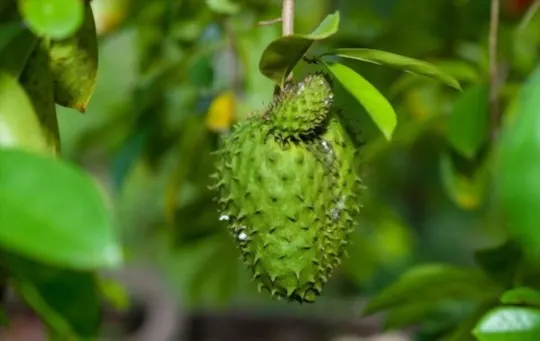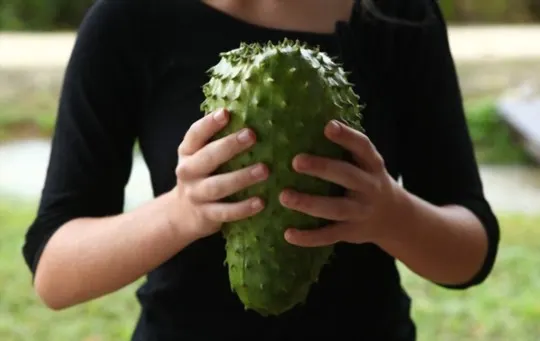Ever wonder what guanabana tastes like? You’re not alone!
This strange-looking fruit, with its spiny outer shell, has many people perplexed as to what exactly it might taste like.
To help clear things up once and for all, we’ve created a comprehensive guide to the flavor and texture of guanabana.
First up – how do you even pronounce it!?
Don’t worry; by the end of this blog post you’ll know more than enough to confidently order guanabana at your local grocer or restaurant.
Read on to find out everything there is to know about this popular tropical fruit!
What is Guanabana?

Guanabana is a tropical fruit that is also known as soursop.
This fruit originates from the Caribbean, Central America, and parts of South America.
It has been grown in other parts of the world due to its high demand and unique flavor profile.
Guanabana is a green, spiny fruit that can grow to be quite large – up to twelve inches long and six inches wide.
Guanabana has been used for centuries in traditional medicine due to its potential benefits in supporting an individual’s immune system.
It contains a class of organic compounds known as acetogenins, which have been studied for their possible anti-cancer properties.
Additionally, guanabana may have anti-inflammatory effects and may help lower blood pressure.
The flesh of guanabana is white with black seeds throughout.
The texture is often described as creamy and custard-like, which makes it ideal for use in desserts such as ice cream or pudding.
The flavor of this fruit is complex and often compared to a mixture of pineapple, strawberry, and coconut.
Overall, guanabana is a versatile fruit used in various culinary dishes ranging from drinks to desserts.
Its unique flavor and potential health benefits make it highly sought after both domestically and internationally.
Now that you know what guanabana is let’s delve into what it tastes like.
What Does Guanabana Taste Like?

Guanabana, also known as soursop, has a unique taste that sets it apart from other fruits.
It can be difficult to describe its flavor since it is a combination of several tastes.
The taste of guanabana can be compared to a mix of pineapple, banana, and strawberry with a hint of sourness.
When you first bite into guanabana, you may notice its creamy texture that coats your mouth in a way that no other fruit does.
The flavor begins with a sweet taste similar to ripe bananas or pineapples.
As you continue to chew, the sourness becomes apparent which is similar to the tartness in strawberries or citrus fruits.
However, the sourness is not overpowering and blends well with the sweetness.
In terms of texture, guanabana is creamy and juicy which adds another layer of complexity to its taste.
The fruit itself has large seeds but its white pulp is what holds all the flavor.
You can eat it raw by scooping out the pulp or use it in various recipes.
Overall, guanabana offers a unique and delightful taste profile that sets it apart from other tropical fruits.
It’s hard to compare its taste to any other specific fruit since it has a combination of flavors that work together harmoniously.
Culinary Uses of Guanabana
Guanabana, also known as soursop, is a fruit that has become popular for its unique taste and numerous health benefits.
The fruit is mainly used in cooking and can be consumed in many different ways.
Guanabana’s unique flavor makes it versatile in the kitchen; it can be used in both sweet and savory dishes.
For those who enjoy experimenting with new flavors, guanabana pulp can be added to sauces or marinades for grilled meats.
In addition to its culinary uses, guanabana leaves are also used to make tea, which is said to have calming properties and aid in digestion.
Overall, guanabana has many culinary uses and offers an exciting twist on traditional dishes.
How to Prepare Guanabana?

To prepare Guanabana, start by selecting a ripe fruit that yields slightly to the touch.
Cut off the top and bottom of the fruit, and make a lengthwise cut around the fruit’s perimeter.
Use your hands to gently separate the segments from the rind, being careful not to damage them.
Once you have separated all of the segments, remove any seeds or white flesh from each one.
This can be done by pressing them through a strainer or cheesecloth with a wooden spoon until only the pulp remains.
The pulp can be used in a variety of recipes, including smoothies, ice cream, jams, and sauces.
Alternatively, you may simply blend the entire fruit (including seeds and white flesh) into a drinkable smoothie or juice.
However, some people prefer to strain out these parts for texture reasons.
When using Guanabana in savory dishes such as stews or curries, it is best to cook it first before adding other ingredients.
Simply simmer cubed Guanabana in water or broth until tender before incorporating it into your recipe.
Overall, there are many ways to prepare Guanabana depending on your personal preference and intended use.
Where to Buy Guanabana and How to Store It?

To buy Guanabana, you can check out your local supermarkets or grocery stores that offer tropical fruits.
You can also try visiting Latin American shops, farmers’ markets or online stores that sell exotic fruits like Guanabana.
Storing Guanabana is quite essential to keep it fresh and healthy for longer.
Here are some tips on where to buy and how to store Guanabana:
- Look for a local Latin American store in your area.
- Check out farmers’ markets that offer exotic fruits like the Guanabana.
- Visit your neighborhood’s supermarket or grocery store, especially those that offer tropical fruits from around the world.
- You can shop online through various websites that provide fresh fruit delivery services.
- If you happen to buy unripe Guanabanas, let them ripe at room temperature until slightly soft before slicing them up.
- Store the ripened fruit in a cool place like the refrigerator; however, try not to stack with other fruits because it tends to emit gas that can spoil them quickly.
While buying Guanabana may take some effort searching for local produce growers, it’s worth knowing a few good resources where you can pick it up quickly.
When storing the fruit at home, pay close attention to their shelf-life as they tend to ripen quite fast and spoil quickly.
It’s best advised to consume them within three days after purchase or storage since they deteriorate rapidly over time.
Proper storage of these tropical delights will keep your pantry packed full of goodness and nutrition.
Conclusion
Guanabana, also known as soursop, is a fruit that is native to the tropical regions of South America and the Caribbean.
This unique fruit has a green exterior with spiky skin and a white, fleshy interior that contains black seeds.
The taste of guanabana can vary depending on ripeness and preparation.
If you are looking for where to buy guanabana, it can be found at specialty grocery stores or local markets in tropical regions.
When selecting your fruit, look for one that is slightly soft to the touch but not mushy.
Guanabanas can spoil quickly if not consumed right away, so make sure to store them in the refrigerator wrapped in plastic wrap or placed in an airtight container.

What Does Guanabana Taste Like? A Comprehensive Guide
Ingredients
- Guanabana
- Ingredients from your selected recipes
Instructions
- Select ingredients that work well together.
- Use a recipe or method that will enhance their natural taste.
- Taste and adjust the recipe as needed to achieve the desired flavor.

Carrie is a food writer and editor with more than 15 years of experience. She has worked for some of the biggest names in the food industry, including Bon Appétit, Food & Wine, and Martha Stewart Living.
As the Editor in Chief of IntroChicago.com, Carrie oversees all of the content on the site. She also manages the team of contributing writers and editors, who help to create delicious recipes, helpful tips, and informative articles that you’ll find on the site.
A native of the Chicago area, Carrie is passionate about all things food. She loves trying new restaurants and experimenting with new recipes in her kitchen. She’s also a graduate of the Culinary Institute of America, so she knows a thing or two about food!
